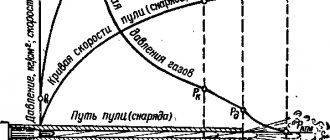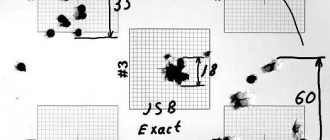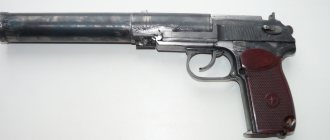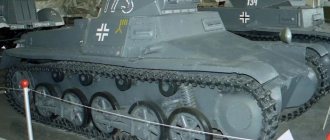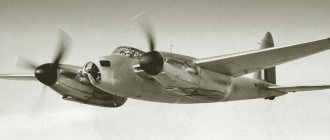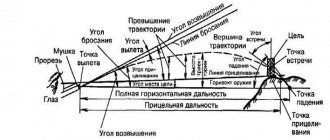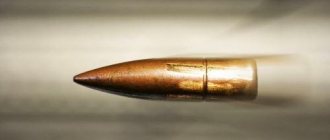Progress is a flexible concept. It depends on many factors, the main ones being laziness (people create technology to make life easier) and war. Thanks to it, humanity is learning to win, to use new types of tactical actions, and also to create more and more powerful deadly weapons, which, if not used, at least frighten the enemy.
A visual photograph of military action (from popular shooters)
The same thing happened during the Cold War and the arms race. The most advanced countries in the world - among them the USA and the USSR - tried to make a breakthrough in the field of military industry. However, only our domestic physicists came up with the idea of creating an atomic bullet. Many Fr. And this is true, but what happened to the Soviet researchers?
An idea ahead of its time - 1960s
In the 60s of the 20th century, Soviet scientists began to think about how to reduce the size of the nuclear bomb while maintaining all its destructive potential. As part of their research, scientists tested many nuclear substances until they stumbled upon a special element, or rather, its isotope. More about it a little later.
Having discovered this substance, scientists dramatically changed their idea, moving from reducing the standard bomb to creating a fundamentally new weapon - the atomic bullet. After all, bombs already exist and everything for them has long been invented, but there are no small bullets that could burn through the thick armor of a tank or even destroy an entire building plus create atomic radiation on a much smaller area of land than a conventional atomic bomb does. In this way, it was possible to conduct military operations selectively, and not immediately destroy entire cities and regions. This method was more humane, and the capture of city after city could have happened faster here.
Information about an attempt to create a nuclear weapon that fits into the size of a machine gun bullet has recently reached us. Similar information began to leak out after the USSR collapsed and Semipalatinsk became the territory of Kazakhstan. But all this was not accurate and resembled fables. The real data was revealed only recently, after the Russian leadership began declassifying archival documents en masse. So what do we now know about atomic bullets, their filling, characteristics and range?
Development of small nuclear weapons in the USA
There is still ongoing debate about who first invented atomic bullets. The first mentions of ultra-small and powerful weapons appeared in the 60s of the last century, when the situation in the world pushed the development of the military industry. The issue of armament with destructive mechanisms was very acute at that time, and the two superpowers - the USA and the USSR - walked side by side in creating nuclear technologies to maintain military parity. Many scientists are inclined to believe that atomic bullets are the work of the minds and hands of American specialists. Their development is based on the idea of destructing living beings within a certain radius of action of a projectile using a special damaging gas released during a nuclear reaction. In the USSR, the development of atomic bullets was a prospect for confronting a potential enemy.
Today, the controversy surrounding this project has subsided; it would seem that the topic has remained in the last century. However, recent publications in the American media forced everyone to remember what atomic bullets are. In Texas, a group of physicists carried out a series of experiments related to testing a bomb filled with hafnium isomer.
In order to obtain this substance, the nucleus of the element was irradiated with X-ray waves. Scientists were amazed: the process released an amount of energy exceeding 60 times the cost of initiation. The quality of the radiation received consisted mainly of the gamma spectrum, which is destructive for living organisms. The destructive ability of hafnium is equal to the equivalent of 50 kg of TNT. This type of weapon accepts the rules for the use of atomic mini-bombs or mini-nukes, which are described in the Bush Security Doctrine.
It is not known for certain whether developments on this issue are being carried out in Russia, however, perhaps in the near future our scientists will have something to respond to the developments of their American colleagues.
Filling of the finished product
Let's return to the topic of nuclear matter. Analyzing the components of existing bombs, scientists made a final verdict: “The uranium 235 or plutonium 239 used is absolutely not suitable for reducing the size of the bomb.” It was necessary to find a new substance, or rather, its powerful isotope, which could produce a similar explosion in smaller volumes.
There is a physical term - critical mass. Its indicator clearly indicates what minimum amount of a substance must be taken in order for it to explode. For uranium and plutonium, the critical mass varies around 1 kg, which is too much for a tiny bullet.
Californium 252 is an approximate type of isotope.
In fact, it is the most expensive metal on the planet and exists at the atomic level, however, scientists claim that it has a bright silvery sheen, and 1 gram of it costs more than 200 million dollars. It is produced only in the USA and Russia. As a result of research, scientists began to study in more detail the specifics of californium and its isotopes. The final data showed that the transuranium element californium, with atomic weight 252, has a critical mass of just 1.8 grams. But that’s not all: during its decay, the California isotope releases from 5 to 8 neutrons, while uranium or plutonium could generate only from 2 to 3 neutrons. This indicator is important for nuclear physicists, as it indicates the destructive capabilities of a substance. Simply put, just a pea of an isotope (about 6 grams) can create a colossal atomic explosion. This discovery shook up the reality of that time. Research continued.
Result
After analyzing all the declassified information on this project, it is possible to create an external description of the bullet. Firstly, 3 types of cartridges were created for different calibers: 14.3 mm, 12.7 mm and 7.62 mm. All calibers were intended for machine guns, but only the first 2 for heavy ones, and the last one for the Kalashnikov machine gun. Consider the 7.62 cartridge.
The exact composition of an atomic bullet
The dimensions and type of the cartridge did not change in any way, however, an “explosive” weighing 6 g was packed into the tip of the bullet in the form of a small ball with a circumference of 8 mm. This size is enough to trigger a good nuclear explosion. But because of the California ball, the projectile became heavier, and the ballistic properties of the steel were very different from the original. Therefore, it was necessary to increase the volume of gunpowder used.
In a word, Russian scientists were able to create a real copy of an atomic bullet. But why was this project closed? What were the reasons for the closure of such a promising idea?
Disadvantages of atomic bullets
Unfortunately, there were plenty of reasons to shut down the Atomic Bullets project. The development of this type of weapon was curtailed mainly due to the strong heating of the cartridges. The fact is that all nuclear substances sooner or later become very hot - this happens depending on the critical mass. The larger it is, the longer the element heats up, the less force is needed to keep it cool. With the smallest critical mass, things are completely different. This means that in order to cool 7.62 mm cartridges, a special refrigerator is needed, since it will not be possible to install a cooling unit inside, which is used in conventional nuclear bombs.
A visual view of the 7.62 mm cartridge for the Kalashnikov assault rifle and machine gun
Moreover, due to the rapidly changing temperature, a lot of thermal energy (5 watts) was released, causing the bullet to increase in size. The main danger was such a projectile getting stuck in the barrel, as well as its spontaneous detonation.
Taking these circumstances into account, scientists created a special refrigerator. It consisted of one thick (15 cm) copper plate, which had recesses for cartridges. The device used ammonia as a coolant and could cool bullets down to -15 degrees. But this did not help save the project, since the installation itself weighed more than 100 kg and was particularly electrically voracious (200 watts). These parameters required transporting the refrigerator by special transport to the shooting site, which only complicated the task.
Regarding the features of application and effectiveness:
- The shells had to be taken out of the refrigerator, had time to load a machine gun, machine gun or sniper rifle, lie down in position and fire a shot. It was necessary to fit in strictly within 30 minutes. After the expiration date, the bullet had to be put back in the refrigerator;
- If the shell lay for more than 1 hour without freezing, then it should have been destroyed using special equipment;
- The projectile was absolutely effective against any frontal attack on a tank. The explosion simply melted the metal and welded it to the tracks, stopping the vehicle and making it unsuitable for firing. The crew of the vehicle died either from an explosion or from nuclear radiation;
- The effectiveness of the cartridge dropped to zero after entering the aquatic environment. The water slowed down and reflected the californium's neutrons, preventing it from igniting;
- Fragility. Unfortunately, California isotope cartridges lost all their potency after 6 years of inactivity. And given the uniqueness of the resource and the high cost of its production using a nuclear reactor, the final answer was not in favor of preserving the project.
Where can these bullets be used?
You must admit that these shells are quite difficult to use military ammunition, and the question naturally arises: “Where are atomic bullets used? For what purposes are they indispensable?” The armor of a modern tank is strong enough for a shell to penetrate right through it. However, this was not required. When an atomic bullet hits a tank, it releases such an amount of heat that the protective layer on the combat vehicle simply evaporates and the metal melts. As a result, the tracks became one with the turret, and the tank turned into a completely immobilized and unusable object. One atomic bullet can turn a cubic meter of brickwork into dust.
Still, no: the USSR stopped the development of the project
You probably noticed that the word “special” appears often in the text, since everything, from the smallest details to standard things, had to be adjusted to the recommended use of the atomic bullet. Otherwise there was a risk of self-detonation. Individual transport, a refrigerator, equipment for eliminating overexposed shells - all this required large investments, and the return, in the opinion of the country's leadership, was minimal.
The leadership of the USSR did not find it expedient to produce such cartridges, not only because they would be too expensive to maintain and create, but also because the energy emitted by California always varied from 100 to 700 kg in equivalent spent. Thus, it was difficult to predict how the projectile would explode and whether the shooter himself would receive a dose of radiation. Even a sniper rifle did not guarantee safety.
Igla MANPADS
However, this did not mean that the very idea of small nuclear weapons was bad. It’s just that at that time there was neither the strength, nor the money, nor the vital necessity to finalize the brilliant idea. The country was already armed with the Strela and Igla anti-aircraft missile systems, which were no less expensive to produce and operate, but more multifunctional. And there were enough simple bombs and shells to destroy any armored or living target without the risk of getting hurt yourself.
It is unknown whether modern development of nuclear cartridges is underway in Russia. Although, given the latest super-efficient Russian developments (the Avangard supersonic missile, the Peresvet laser complex, the Burevestnik cruise missile, the Poseidon unmanned submarine and the Kinzhal anti-ship missile), we will not be surprised if scientists pull out a forgotten one from the dusty archives Project "Atomic Bullets".
Costly, unpredictable and exotic
The history of the creation of atomic bullets was forced into oblivion along with the introduction of a moratorium on testing weapons with nuclear potential. The whole problem was that those reserves of californium that were obtained through powerful explosions disappear quite quickly.
There was only an alternative way to obtain it - using a nuclear reactor. However, this method was considered expensive, and the yield of the valuable element was small. This kind of circumstances was reinforced by the absence of an urgent need for further development of the development of atomic bullets. The leadership of the country's defense forces decided that the enemy could be destroyed with ammunition that did not require so much effort in production, storage and movement. In this regard, the USSR project “Atomic Bullets” was curtailed and sent to gather dust on the shelves of secret archives.
Nowadays, most likely, you can see the developments of those years somewhere in museums or in private collections of rarities, but their effectiveness has long been lost. The fact is that the shelf life of these bullets is limited to six years. It is possible that research is currently underway to improve miniature atomic projectiles with californium, but Herculean work must be done to make them convenient for use and reduce the cost of their production. Defying the laws of physics is quite difficult. Whatever one may say, atomic bullets with californium as a filling have negative characteristics:
- get very hot during storage;
- need constant cooling;
- they must be used no later than half an hour after defrosting;
- unstable and unregulated charge explosion power;
- are neutralized when exposed to water;
- Producing californium in a nuclear reactor is a lengthy and expensive process.
The combination of these circumstances was the reason that the USSR mothballed the incredible project called “Atomic Bullets” until better times. The point is not even that there was a pity for money for the further development of these military weapons. The country's leadership considered this project impractical and too exotic for the early 80s.
Currently, Russia has several mobile anti-aircraft missile systems in its arsenal, such as Strela and Igla. Their design includes a homing system that requires cooling to -200˚C. This is done by creating a liquid nitrogen environment and is also not cheap. However, this does not serve as a reason for the Ministry of Defense to consider this weapon to be overly complex in design and inappropriate.
Maintaining the state's combat power justifies the use of such expensive technologies. Perhaps in the future a portable mini-cooling system for atomic bullets will be developed, and they will be in service with the most ordinary soldiers.
